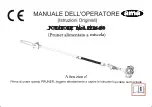
the edge of the panel. (
Fig. 1
)
To minimize the risk of blade pinching
and kickback, when cutting operation
requires the resting of the saw on the
workpiece, the saw should be rested
on the larger portion and the smaller
piece cut off. (
Fig. 1&2
)
Do not use dull, deformed, cracked or
damaged blade. Unsharpened or improperly set blades produce narrow
kerf causing excessive friction, blade binding and KICKBACK. Keep blade
sharp and clean. Gum and wood pitch hardened on blades slows saw and
increases potential for kickback. Keep blade clean by first removing it from
tool, and then cleaning it with gum and pitch remover, hot water or kerosene.
Never use gasoline.
Blade depth and bevel adjusting locking levers must be tight and secure
before making cut. If blade adjustment shifts while cutting, it may cause
binding and KICKBACK.
Use extra caution when making a
“Plunge Cut” into existing walls or other
blind areas. The protruding blade may cut objects that can cause
KICKBACK. For plunge cuts, retract lower guard using Retracting Lever.
ALWAYS hold the tool firmly with both
hands. NEVER place your hand or
fingers behind the saw. If kickback
occurs, the saw could easily jump
backwards over your hand, leading to
serious personal injury. (
Fig. 3
)
Never force the saw. Forcing the saw
can cause uneven cuts, loss of accuracy, and possible kickback. Push the
saw forward at a speed so that the blade cuts without slowing.
16. Use the appropriate riving knife for the blade being used. For the riving knife to
work, it must be thicker than the body of the blade but thinner than the tooth
set of the blade.
17. Adjust the riving knife as described in this instruction manual. Incorrect spacing,
positioning and alignment can make the riving knife ineffective in preventing
kickback.
18. Always use the riving knife except when plunge cutting. Riving knife must be
replaced after plunge cutting. Riving knife causes interference during plunge
cutting and can create kickback.
19. For the riving knife to work, it must be engaged in the workpiece. The riving knife is
ineffective in preventing kickback during short cuts.
20. Do not operate the saw if riving knife is bent. Even a light interference can slow the
closing rate of a guard.
21. Use extra caution when cutting damp wood, pressure treated lumber or wood
containing knots. Adjust speed of cut to maintain smooth advancement of tool
without decrease in blade speed.
22. Adjustments. Before cutting be sure depth and bevel adjustments are tight.
23. Avoid Cutting Nails. Inspect for and remove all nails from lumber before cutting.
24. When operating the saw, keep the cord away from the cutting area and position it
so that it will not be caught on the workpiece during the cutting operation. The tool
is provided with a front grip and rear handle for two hand operation. Operate with
proper hand support, proper workpiece support, and supply cord routing away from
the work area.
WARNING:
It is important to support the
workpiece properly and to hold the saw firmly
to prevent loss of control which could cause
personal injury.
Fig. 4
illustrates typical hand
support of the saw.
25. Place the wider portion of the saw base on
that part of the workpiece which is solidly
supported, not on the section that will fall off
when the cut is made.
As examples,
Fig. 5
illustrates the RIGHT way
to cut off the end of a board, and
Fig. 6
the
-7- -8-




























